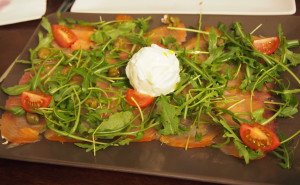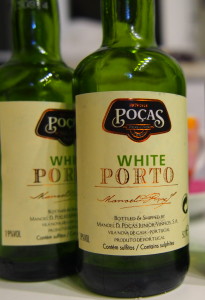Portugal is the most western point of Europe so it makes sense that many foods worked their way from the ports of Portugal up through the rest of Europe. Of course, the Portuguese were prolific explorers in their own right and brought many foods from all over the world to their shores.
If you have ever looked at the flag of Portugal you may have noticed that round ball in the center- that round ball was an early navigation tool that helped them to navigate and explore as much as they did. It helped position Portugal as a European powerhouse and helped them acquire a zest for foods of the world.
In the early 16th century sailors caught cod off the coast of Newfoundland, they salted and dried the cod to get it back to Portugal where it has become the national dish and is wildly popular. Portugal has been doing their own version of fusion cuisine for centuries!
They pull influences from all over the world and have a variety of flavors with which to work with. The food is robust and delicious. Pork is definitely the most used meat, but chicken and beef are also common. On a tour of the city, our guide informed us that grilling is probably the most common technique, “if it moves, grill it” is what he told us.
Cinnamon, piri-piri, pepper, strong, flavorful olive oils, vanilla, parsley and cilantro are all popular flavors that you will see popping up again and again! To help us learn more about Portuguese food, we reached out to Portuguese food blogger Maria Dias of Tia Maria’s and Portuguese Diner.
From her we learned that the Moors and Romans influenced Portugal’s cuisine in earlier times and that colonization in Africa and the Far East helped bring spices and other flavors to Lisbon. She reports that through Portuguese exploration the world was introduced to “many spices and wines, citrus fruits, potatoes, corn, chili and even coffee” Check out the very interesting full interview HERE.
Looking for something a bit Healthier?
Fortunately, seafood and shellfish are very popular and many of the restaurants have a large selection of grilled fish; sardines are especially popular. Most meals also come with a small salad of lettuce, tomato and onion.
High in omega-3 fatty acids and one of the most sustainable fish in the ocean, sardines with a house salad, olive oil and vinegar are not only one of the healthiest lunches you can get, but also one of the tastiest! Because of the mild climate, there are also plenty of fresh fruits and vegetables available at markets.
According to Maria, “The cuisine features all varieties of green vegetables such as; collard greens, kale, cabbage…” She goes onto say that heart healthy beans are also very popular in the cuisine, especially “red, white, chickpeas, fava beans, and black eyed beans.” Beans are a great choice thanks to their antioxidants, fiber, complex carbs and high protein content.

Must Try
Pastel de Nata
These custard tarts are sold at pastelerias all over the city. They have a flaky, buttery crust and a creamy, luxurious custard filling. They come plain but on the tables are shakers full of cinnamon and powdered sugar to add some pizzazz. I highly recommend copious amounts of cinnamon sprinkled on top- yum!!

Grilled Sardine
Simply one of the most simple and most delicious meals you can get. Eat the sardines skin and all (watching our for the backbone) topped with the vinegar and the strong olive oil sitting at the table.
Arroz de Marisco
Similar to paella, this is saffron rice served with a variety of shellfish including clams, prawns and a few diced veggies.
Cod (bacalhau)
We were informed that there are hundreds of ways to prepare salted cod in Lisbon, so give it a whirl at some point while you are there. Look for popular varieties like pasteis de bacalhau which is a dish similar to a croquette- salted cod mixed with mashed potatoes and then deep fried.
Caldo Verde
Kale soup, made with strong olive oil, potatoes, garlic and onions this hearty, warming soup is especially popular in winter.
What to Drink
Port
Look especially for the reserve vintage ports as these identify exceptionally good years. Definitely head to a wine store to learn about the different varieties from tawny to ruby to reserve vintages and the difference between 10, 20 and 40 year ports and have a few samples. It is incredibly educational and the ports are incredible!

Wine
Try the Vinho Verde, a lightly sparkling wine that has many characteristics of a white wine, but is its own, unique and delicious kind of wine. Of course, there are a variety of different whites and reds that are all unique to Portugal and you cannot go wrong with any of them!
Restaurants to Try
Obviously not an inclusive list, if you know of another great restaurant, let me know so I can include it!
The Corkscrew
Hidden on the winding streets of Alfama, this restaurant is totally worth getting lost for. We tried several of the tapas including the sardines, blood sausage and the salmon- the portions were quite large and everything was delicious. The service was attentive and the wine selection was extensive. Note the large leg of Iberico ham sitting on the bar.
Super Mario
A tiny, locals only kind of restaurant. Florescent lights and plastic table clothes make up the decor, but the food is absolutely outstanding and reasonably priced (about 9 euros for a 2 person portion). Definitely a no frills kind of place, this is a great option if you want to drink wine with the locals and if you want great food at a good price
Marques
Another local gem hidden behind a bombeiros station. A small menu, based mostly on the fish of the day it is another no frills but incredibly tasty restaurant. While there are plenty of other, fancier restaurants right near it, the food is not as good and the prices are much, much higher!
Manteigaria
Not the original pastéis de nata, but definitely my favorite with a thinner crust and a less eggy custard. Listen for the bell, it rings 5 times when there are fresh pasteis de nata!
Café Pastéis de Belém
Home of the original pastéis de Belém, they have been using the same top-secret recipe since 1837 and the lines outside the door show just how popular they are! Here is a secret- the line is for take away pastéis de Belém. Head inside the restaurant for table service and skip the line! Not my favorite (but still good!) it is an experience to go here and trying the original is highly recommended!
Other Notes
The bread one the table is not free. In fact, even if the server comes and drops bread or other appetizer looking things (for example, we had chips and salsa at one restaurant) on the table without asking, you will be charged. You may be charged only for what you eat, or you may be charged for the whole basket, if you don’t want to pay, don’t eat it. For what it’s worth, the bread is delicious and we were never able to resist the temptation.
Lunches are traditionally long, lingering affairs. Dinner is served late, with meals finishing around 9-9:30pm.
If you order squid or cuttlefish- you may be asked “with or without?” This question refers to the ink. They may not ask and you may end up with the ink still in. The cuttlefish is good both ways, but the ink does turn your mouth, tongue, teeth and lips black.
Beware of the oranges! Many of the orange trees in Lisbon are wild- and the oranges are incredibly sour! Keep that in mind if you decide to try one.
The traditional chicken of Portugal (i.e Nando’s) is not a real thing. Somewhere along the way in it was invented, so tourists came looking for it. Because tourists expected it, restaurants started making it. However, it is not an authentic, traditional dish.
Try Your Hand at Portuguese Cuisine
If you want to make some Portuguese dishes your self try Maria Dias’s new book Taste Portugal | 101 easy Portuguese recipes.

